Recent Posts
A Simple Guide to Choosing the Right Fire Restoration Partner
4/9/2024 (Permalink)
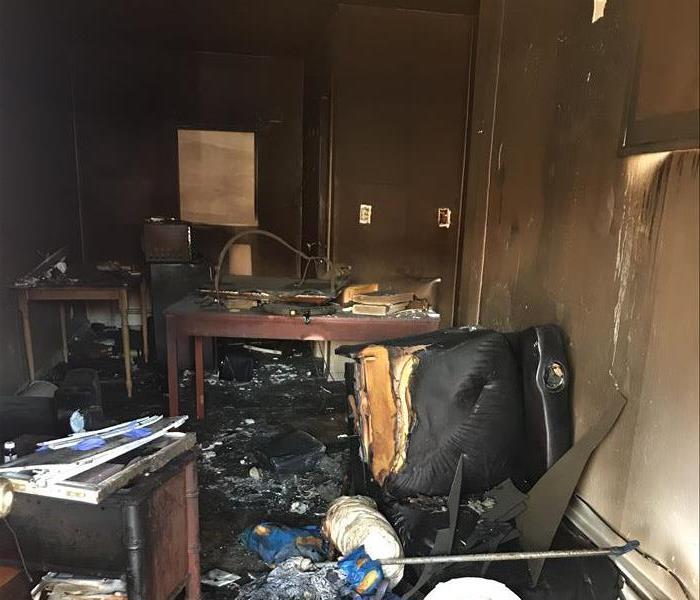 Choosing a reputable fire restoration company is a crucial step in the recovery process after a fire.
Choosing a reputable fire restoration company is a crucial step in the recovery process after a fire.
When faced with the aftermath of a fire, selecting the right restoration company is a crucial decision that can significantly impact the recovery process. In this guide, we'll walk you through practical steps to help you choose a reputable fire restoration company, ensuring a smooth and effective restoration journey.
Certification Matters
Begin your search by checking for certifications. A reputable fire restoration company should hold certifications from recognized organizations like the IICRC (Institute of Inspection, Cleaning and Restoration Certification). These certifications guarantee that the technicians are trained to industry standards, providing you with the assurance that your restoration is in capable hands.
Immediate Response Time
Time is of the essence in fire restoration. Look for a company that emphasizes a quick and responsive approach. A company with a 24/7 emergency line and a commitment to immediate response can prevent further damage and kick-start the restoration process promptly.
Comprehensive Services
Choose a company that offers a range of restoration services. Fire damage often involves various challenges, from structural issues and water damage to smoke and odor removal. A one-stop shop for comprehensive restoration ensures that all aspects of the damage are addressed efficiently, saving you time and effort.
Local Reputation
Investigate the company's local reputation by checking online reviews and testimonials. A solid track record in your community speaks volumes about the quality of their service. Look for feedback on their professionalism, response time, and the effectiveness of their restoration work.
Clear Communication
Effective communication is key during the restoration process. Choose a company that communicates clearly and transparently. They should be able to explain the restoration plan, provide detailed estimates, and keep you informed about the progress of the work. Clear communication fosters trust and ensures that you are on the same page throughout the restoration journey.
Proper Licensing and Insurance
Ensure that the restoration company is properly licensed and carries adequate insurance. This not only safeguards your property but also protects you from potential liabilities. Ask for proof of insurance and licensing to guarantee that you are working with a legitimate and responsible service provider.
Selecting a reputable fire restoration company is a crucial step in the recovery process after a fire. By considering factors such as certifications, prompt response time, comprehensive services, local reputation, clear communication, and proper licensing, you can make an informed decision that sets the foundation for a successful restoration. Remember, the right restoration partner not only brings your property back to life but also provides the support and expertise needed during a challenging time.
7 Steps to Keeping Your Kitchen Mold-Free
3/12/2024 (Permalink)
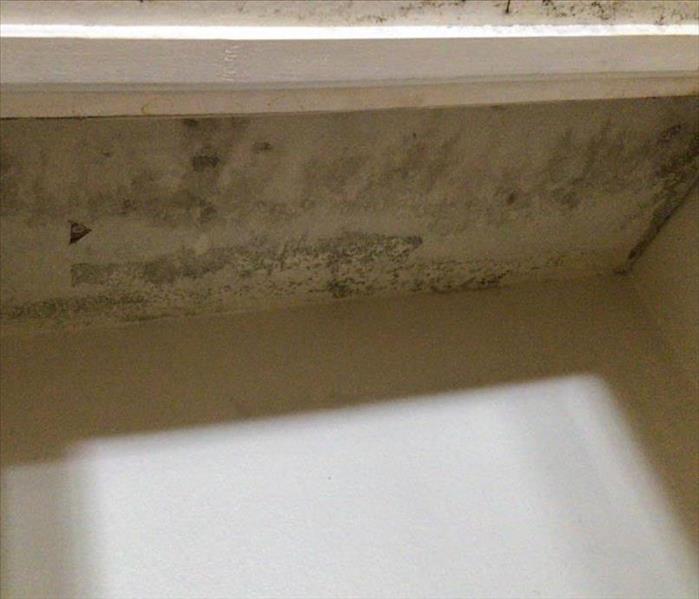 Remember, a mold-free kitchen is a stress-free kitchen!
Remember, a mold-free kitchen is a stress-free kitchen!
Welcome to the heart of your home – the kitchen. While can be a hub of delicious treats, it can also be a breeding ground for an unwelcome guest – mold. Fear not, as experts in the field, we’re here to guide you through straightforward steps to prevent mold in your kitchen. No overly complicated methods – just practical advice to keep your kitchen mold-free.
1. Control Moisture
Mold's best friend is moisture, so the first line of defense is controlling it. Fix any leaks immediately, wipe down wet surfaces, and ensure your kitchen is well-ventilated. Proper ventilation, whether through an exhaust fan or open windows, helps reduce humidity and keeps mold from growing.
2. Regular Cleaning
A clean kitchen is a mold-free kitchen. Regularly wipe down surfaces, especially those prone to moisture, like the sink and countertops. Don't forget hidden corners – mold loves to lurk in the shadows.
3. Dry Your Dishes Thoroughly
Dish racks and damp dish towels can be hotspots for mold growth. Ensure your dishes, utensils, and dish racks are thoroughly dried before putting them away. A small effort in drying can prevent mold from finding a cozy home in your kitchen.
4. Check the Refrigerator Drip Pan
The refrigerator drip pan is often overlooked but can be a secret hideout for mold. Regularly check and clean the drip pan to prevent mold growth. A quick inspection during routine cleaning can save you from unpleasant surprises.
5. Store Food Properly
Proper food storage not only ensures freshness but also prevents mold. Use airtight containers to keep dry goods, and promptly refrigerate perishable items. Regularly check your pantry for expired items and dispose of them to discourage mold growth.
6. Clean Appliances Regularly
Appliances like the dishwasher and coffee maker can become mold havens if neglected. Regularly clean and maintain these appliances according to the manufacturer's recommendations. This not only ensures their efficiency but also eliminates potential mold sources.
7. Maintain a Well-Organized Kitchen: Less Clutter, Less Mold
A clutter-free kitchen not only looks appealing but also makes it harder for mold to find hiding spots. Regularly declutter your kitchen, discard unnecessary items, and organize storage areas to promote proper air circulation.
In conclusion, preventing mold in your kitchen is a practical endeavor. By incorporating these 7 simple strategies into your routine, you'll not only keep your kitchen mold-free but also create a healthier and more enjoyable cooking environment. Remember, a mold-free kitchen is a stress-free kitchen!
Post-Restoration Home Maintenance: Preventing Future Damage
1/17/2024 (Permalink)
After experiencing a water damage event, it is crucial to address the issue immediately through professional restoration services like SERVPRO®. Once the restoration is complete, your home's condition and safety are restored, but preventive measures should be taken to prevent future damage. This blog will detail post-restoration home maintenance tips that will help prevent future water damage and protect your home.
Regular Inspection and Maintenance of Plumbing System
Your home's plumbing system is susceptible to wear and tear, resulting in leaks and water damage. Conduct regular inspections of pipes, valves, and appliances to ensure they are functioning adequately and promptly repair or replace aging or damaged components.
Excess moisture can cause mold growth, corrosion, and other water-related issues. Proper ventilation and dehumidification help to control the moisture levels in your home, reducing the risks of mold and other water damage issues.
Clean and Maintain Gutters
Gutters and downspouts play a crucial role in protecting your home by diverting water away from the foundation. Clean gutters regularly to prevent clogging, which can lead to water infiltration and potential damages.
Your home's roof can take a considerable beating from weather conditions and environmental factors. Regular roof inspections, repairs of leaks, and adequate insulation can prevent water intrusion and related issues like mold, rotting, and interior water damage.
Landscape and Drainage Management
Proper landscaping practices help prevent water damage to your home. Ensure that your drainage system effectively diverts water away from the home's foundation by directing water flow off the property, using downspout extensions and grading the landscape appropriately.
Conduct Regular Home Inspections
A regular home inspection by a professional can help identify potential issues before they become major water damage concerns. This is especially necessary when moving to a new home or after significant weather events. Faulty appliances and equipment like washing machines, dishwashers, and water heaters can lead to water damage if left unattended. Consequently, it is essential to conduct maintenance checks on appliances regularly.
Post-restoration home maintenance is critical to ensure your home stays safe and free from water damage. Diligently following these tips can prevent potential water damages, saving homeowners untold costs and peace of mind. Proper home maintenance is essential for ensuring the longevity and comfort of your home, making it crucial to prioritize water damage prevention.
Cracking the Code: The Science Behind Lightning – Debunking Myths and Unveiling Reality
1/3/2024 (Permalink)
Lightning, a dazzling display of nature's power, has long captivated human fascination. However, myths and misconceptions about this natural phenomenon have persisted throughout history. In this blog, we'll delve into the science behind lightning, dispelling common myths and uncovering the reality of this electrifying spectacle.
Myth: Lightning Never Strikes the Same Place Twice
Reality: Lightning Can Strike Repeatedly. Contrary to the popular saying, lightning can and does strike the same place more than once. In fact, tall structures such as skyscrapers, communication towers, and even certain trees are often struck repeatedly during thunderstorms due to their height and conductivity.
Myth: Lightning Only Occurs during Rainstorms
Reality: Lightning Can Happen in Clear Skies. While thunderstorms are a common breeding ground for lightning, it's not exclusive to rainy weather. Dry thunderstorms, characterized by lightning and thunder without precipitation reaching the ground, can occur in arid regions. Lightning can also happen within the eyewall of a hurricane, even when the surrounding area experiences clear weather.
Myth: Rubber Tires Protect You from Lightning in a Car
Reality: A Car's Metal Shell Offers Protection. While it's true that the rubber tires provide insulation against electric current on the ground, the metal shell of a car is the primary reason it offers protection. If lightning were to strike a car, the metal exterior would act as a Faraday cage, directing the electrical charge around the occupants and into the ground, keeping them safe.
Myth: Lightning Never Strikes the Ocean
Reality: Lightning Can and Does Strike Water. Lightning can strike bodies of water, including oceans, lakes, and rivers. In fact, it's not uncommon for lightning to hit the ocean during thunderstorms. The electrical discharge can travel through the water, posing a risk to aquatic life and those in or near the water.
Myth: If It's Not Raining, There's No Risk of Lightning
Reality: Lightning Can Occur Without Rain. Clear skies don't necessarily mean you're safe from lightning. Lightning bolts can extend for miles from the parent thunderstorm, striking the ground even when it's not raining at your location. This phenomenon, known as a "bolt from the blue," highlights the unpredictable nature of lightning.
Myth: Lightning Never Strikes the South Pole
Reality: Lightning Can Reach Anywhere on Earth. No location on Earth is exempt from the possibility of lightning strikes. While thunderstorms may be less common in polar regions, they can still occur, bringing lightning to even the remotest corners of the globe.
Understanding the science behind lightning helps dispel common myths and promotes a more accurate appreciation of this awe-inspiring natural event. While lightning is a captivating spectacle, it's crucial to approach it with a respect for its power and potential risks. By separating fact from fiction, we can better prepare for thunderstorms, stay safe, and marvel at the fascinating science behind the bolts that light up our skies.
The Distinct Differences: Fire Damage Restoration vs Smoke Damage Restoration
11/15/2023 (Permalink)
When a fire ravages your home or business, the process of restoring it to its preloss condition can be overwhelming. With damage ranging from the actual flames to smoke and soot, the restoration process is a bit more complicated than just cleaning up the ashes.
Fire damage restoration is the process of restoring a property back to its pre-fire condition. This includes repairing walls, floors, and ceilings that may have been damaged by flames and soot. Smoke damage restoration focuses on removing the smoke odor and traces of soot that comes from the smoke.
Here are some key differences between fire damage restoration and smoke damage restoration:
- Cause of Damage - Fire damage restoration and smoke damage restoration both involve cleaning and repairing property damage. However, fire damage is caused by actual flames that can destroy structures and belongings, while smoke damage is caused by the smoke produced by the fire.
- Type of Damage - Fire damage can cause structural damage to a building, whereas smoke damage can affect the air quality. The smoke produced by a fire can spread throughout the building, leaving a layer of soot on surfaces that must be cleaned.
- Restoration Process - Fire damage restoration may involve removing and replacing damaged materials, such as drywall or flooring. Smoke damage restoration involves removing the odor and stains caused by smoke and soot. This may require deep cleaning of carpets, furnishings, and even the walls.
- Professional Restoration Services - Due to the complexities involved in fire and smoke damage restoration, it's important to hire a professional restoration company. Such companies possess the expertise to determine the extent of the damage and take the necessary steps to restore the property back to its preloss condition.
- Timeframe for Restoration - Fire damage restoration and smoke damage restoration can both be time-consuming processes. However, in many cases, smoke damage restoration may take longer due to the need to thoroughly clean the property and remove all traces of smoke and soot.
One crucial aspect of fire damage restoration is assessing the structural integrity of the affected building. Fires can weaken walls, ceilings, and other structural components, posing safety risks. This requires a thorough inspection by experts who can determine the extent of the damage and the necessary repairs. On the other hand, smoke damage restoration focuses on eliminating the pervasive odor and residue left behind by smoke particles. Specialized techniques such as thermal fogging and ozone treatments are employed to neutralize the odor, ensuring that the property is not only visually restored but also free from the remnants of smoke damage. By addressing both fire and smoke damage separately, restoration professionals can ensure a comprehensive restoration process that restores the property to its pre-fire and pre-smoke conditions, providing peace of mind to homeowners and business owners alike.
In conclusion, while fire and smoke damage can be devastating, it's important to understand the distinct differences between them and how to approach their restoration. By working with a professional restoration company and understanding the specific needs of your property, you can help ensure that the restoration process runs as smoothly and efficiently as possible.
Bathroom Mold: Causes, Prevention, and Removal
10/24/2023 (Permalink)
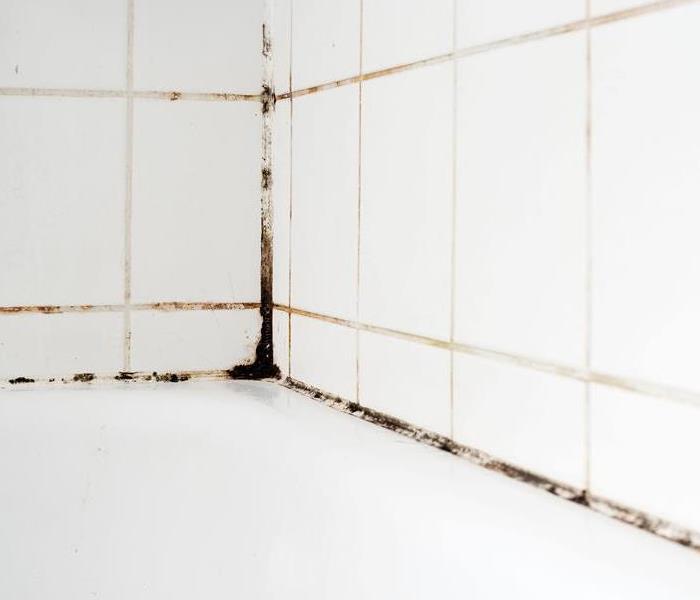 Prevent mold in the bathroom by cleaning and consistent maintenance.
Prevent mold in the bathroom by cleaning and consistent maintenance.
Dealing with mold in the bathroom is a common issue that many homeowners face. Mold growth can occur due to factors such as excess moisture, humidity, and poor ventilation. In this blog, we will explore the causes of bathroom mold and discuss effective prevention and removal strategies without focusing on health risks and concerns.
Excess Moisture
Bathrooms are naturally moist environments, providing optimal conditions for mold growth. Excessive moisture from activities like bathing and showering, combined with inadequate ventilation, can lead to dampness and mold infestation. Properly managing moisture levels by using ventilation fans, wiping down surfaces, fixing leaky fixtures, and ensuring proper sealing in shower areas can help prevent mold growth.
Poor Ventilation
Inadequate ventilation is a common factor in bathroom mold growth. When humid air lingers in the bathroom without proper airflow, it creates an ideal breeding ground for mold. Installing and using exhaust fans, opening windows after showering, and ensuring proper ventilation ducts are clear of debris can help improve airflow and reduce moisture build-up.
Waterproofing and Sealant Issues
Waterproofing and sealing in bathrooms are crucial to prevent moisture penetration into walls, floors, and other surfaces. Damaged or deteriorated sealant around bathtubs, showers, or sinks can allow water to seep into gaps, creating potential mold growth. Regularly inspecting and resealing these areas can help maintain a moisture-resistant barrier and prevent mold-related issues.
Effective Removal Strategies
If bathroom mold does appear, it is essential to address it promptly and effectively. This involves wearing protective gear, isolating the affected area, and utilizing appropriate cleaning solutions or mold-killing products. Thoroughly scrubbing affected surfaces and eliminating any mold-infested materials, like towels or shower curtains, can help prevent further contamination or regrowth.
Bathroom mold is a common problem that can impact the aesthetics and cleanliness of your space. By understanding the causes—excess moisture, poor ventilation, and sealant issues—and implementing preventative measures, you can significantly reduce the likelihood of mold growth. Timely removal and maintenance practices will help keep your bathroom mold-free, ensuring a clean and fresh environment.
When it comes to preventing bathroom mold, consistent maintenance and vigilance are key. Regularly inspecting the room for water damage, leaks, or deteriorated sealant can help you identify and address any potential issues before they escalate into full-blown mold infestations. In addition, establishing a regular cleaning routine using mold-inhibiting products can significantly reduce the likelihood of mold growth. Ultimately, taking proactive steps to prevent and remove bathroom mold will help you maintain a clean, healthy, and pleasant living environment.
Tips for Homeowners to Stay Safe During Water Damage Cleanup
10/16/2023 (Permalink)
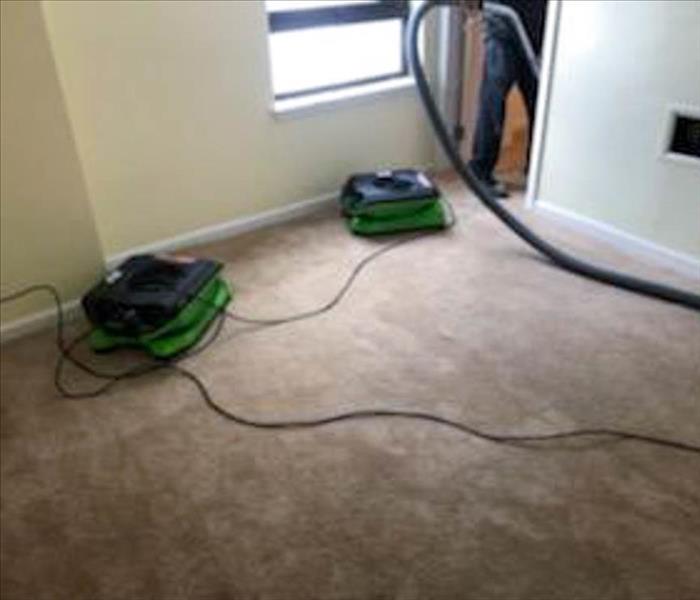 While minor water damage cleanup can often be handled by homeowners, many situations may require professional assistance.
While minor water damage cleanup can often be handled by homeowners, many situations may require professional assistance.
Water damage can be a stressful and disruptive event for homeowners. Whether it's a burst pipe, a flooded basement, or a roof leak, responding quickly and effectively is crucial to minimize damage and prevent long-term problems. However, in the midst of the cleanup process, it's essential to prioritize your safety. In this blog post, we will discuss important tips and precautions to protect yourself during water damage cleanup.
Personal Protective Equipment (PPE)
Before you begin the cleanup process, make sure you have the necessary personal protective equipment (PPE) to protect yourself from potential hazards. This may include waterproof gloves, protective eyewear, rubber boots, and a face mask. PPE will help shield you from contaminants in the water, such as bacteria, chemicals, and sewage, reducing the risk of health issues.
Disconnect All Power Sources
Water and electricity do not mix well. To avoid electrocution or other electrical hazards, it's crucial to disconnect all power sources in the affected area before starting the cleanup. This includes turning off the electricity at the main breaker or calling a professional electrician to ensure it is done safely. Never step into standing water if there is a risk of electrical appliances or outlets being submerged.
Identify Potential Hazards
Water damage can weaken structures, making them unstable. Before entering the affected area, conduct a thorough assessment of the surroundings to identify any potential structural issues, such as sagging ceilings, compromised floors, or crumbling walls. Additionally, be cautious about slippery surfaces caused by water, mud, or debris. Using sturdy and stable pathways, wearing non-slip footwear, and avoiding unstable areas can help prevent accidents and injuries.
Dispose of Contaminated Items
Water damage often results in the destruction of personal belongings and furniture. Depending on the level of contamination, some items may need to be properly disposed of to ensure your safety. Porous materials like carpets, padding, and upholstered furniture that have come into contact with black water or sewage should be discarded. Follow local regulations and guidelines for disposing of contaminated items to prevent risk.
Practice Proper Cleaning and Sanitization
Use EPA-approved disinfectants to thoroughly clean surfaces and prevent the growth of mold and bacteria. It's essential to clean not only visible areas but also hidden spaces, such as behind walls or under flooring, where moisture may have seeped. Proper ventilation with fans and dehumidifiers can help expedite the drying process and reduce the risk of mold growth.
Seek Professional Assistance
While minor water damage cleanup can often be handled by homeowners, certain situations may require professional assistance. If the water damage is extensive, contaminated with sewage, or poses a risk to your health and safety, it's best to call a reputable water damage restoration company. These professionals have the expertise, equipment, and experience to handle more complex restoration tasks, ensuring a thorough and safe cleanup process.
Water damage cleanup requires swift action, but it's essential to prioritize your safety throughout the process. By wearing appropriate personal protective equipment, disconnecting power sources, identifying potential hazards, properly disposing of contaminated items, practicing proper cleaning and sanitization, and seeking professional help when needed, you can protect yourself from potential dangers. Remember, your well-being is paramount during water damage cleanup, and taking the necessary precautions will help you navigate the process safely and effectively.
How to Prepare for Storms
9/12/2023 (Permalink)
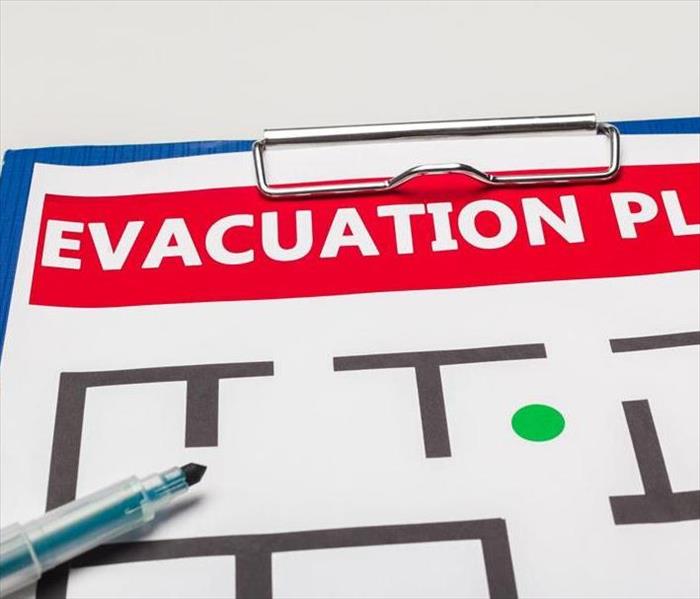 Create a family emergency plan is essential to ensure your family is safe incase of an emergency.
Create a family emergency plan is essential to ensure your family is safe incase of an emergency.
Storms can be unpredictable and have the potential to disrupt our lives and put our safety at risk. That's why it's crucial to have a well-thought-out family emergency plan in place to ensure the safety and well-being of your loved ones. In this blog post, we will discuss the steps to create a comprehensive family emergency plan that can be applied to any storm scenario.
Assess Your Risks
The first step in creating a family emergency plan is to assess the risks specific to your area. Different locations are prone to different types of storms, such as hurricanes, tornadoes, or blizzards. Research the common types of storms that affect your region and consider the potential risks, including flooding, power outages, or evacuation orders. Understanding the risks will help you tailor your emergency plan to address the specific challenges you might face.
Communication Plan
Establishing a communication plan is crucial during storms when power outages or disrupted communication networks can occur. Make sure each family member knows the emergency contacts, including phone numbers of relatives, neighbors, and out-of-state contacts who can serve as a point of contact. Consider creating a group text or using a messaging app to stay connected. Also, determine a meeting place in case you are separated and unable to communicate.
Emergency Supplies
Stocking up on emergency supplies is important before any storm strikes. Create an emergency kit that includes essential items such as non-perishable food, water, flashlights, batteries, a first aid kit, and necessary medications. Keep this kit in a designated, easily accessible area of your home. Additionally, consider having a battery-powered or hand-cranked radio to stay informed about weather updates and any official instructions.
Evacuation Plan
In some situations, evacuation may be necessary. Research the evacuation routes in your area and familiarize yourself with them beforehand. Discuss with your family where you will go if you need to evacuate, whether it's staying with relatives, in a hotel, or at a designated emergency shelter. Plan for transportation and be aware of any evacuation orders or recommendations issued by local authorities.
Home Safety Measures
Prepare your home for storms by taking appropriate safety measures. Trim trees and remove any dead branches or trees that could potentially fall and cause damage. Secure outdoor furniture or objects that could become projectiles in high winds. Consider installing storm shutters or reinforcing windows to protect against strong winds. If you live in a flood-prone area, elevate valuable belongings or consider investing in sandbags to prevent water damage.
Emergency Information and Resources
Stay informed about storm alerts, weather updates, and emergency instructions from local authorities. Sign up for emergency alerts and follow reliable sources of information such as local news channels, weather apps, or the National Weather Service. Familiarize yourself with emergency resources in your area, including shelters, evacuation routes, and disaster assistance programs.
Practice and Review
Once your family emergency plan is in place, it's important to practice and review it regularly. Conduct drills to ensure that everyone knows their roles and is familiar with the plan. Update contact information, emergency supplies, and evacuation routes as needed. Periodically review and discuss your family emergency plan to address any changes in circumstances or new information.
Creating a comprehensive family emergency plan is essential to ensure the safety and well-being of your loved ones during any storm scenario. Assessing the risks, establishing a communication plan, stocking up on emergency supplies, having an evacuation plan, implementing home safety measures, and staying informed are all crucial elements of a well-prepared emergency plan. By following these steps and regularly practicing your plan, you can better protect your family and navigate through storm situations with confidence and resilience.
How to Create an Office Fire Escape Plan: Ensuring Workplace Safety
8/10/2023 (Permalink)
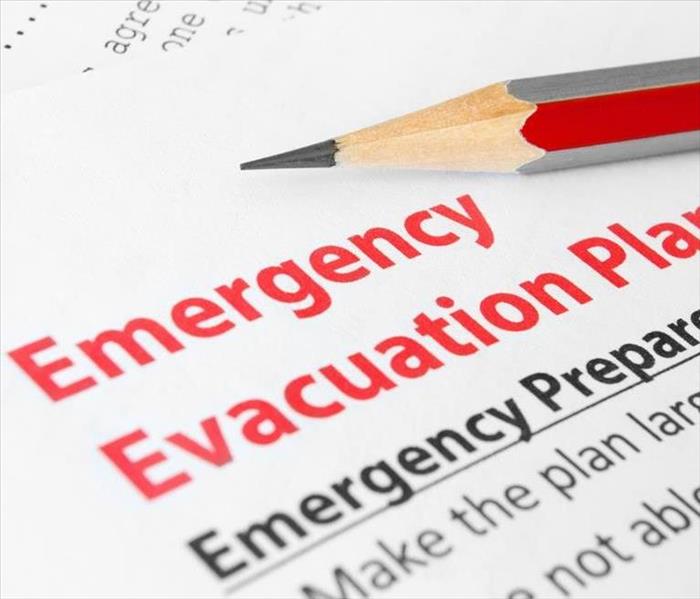 Having an emergency plan in place is essential to having a workplace prepared for an emergency.
Having an emergency plan in place is essential to having a workplace prepared for an emergency.
In any workplace, it is crucial to prioritize the safety of employees in the event of an emergency, such as a fire. Having a well-thought-out fire escape plan is essential to ensure the swift and safe evacuation of everyone in the office. In this blog post, we will guide you through the steps of creating an effective office fire escape plan to protect your employees and your business.
Assess the Office Layout
Start by thoroughly assessing the layout of your office space. Identify all possible exit routes, including doors, staircases, emergency exits, and windows. Take note of any potential obstacles or hazards that may impede the evacuation process, such as cluttered areas, furniture placements, or narrow pathways.
Designate one or more assembly points outside the office building where employees can gather and be accounted for after evacuating. Choose a location that is a safe distance away from the building and easily identifiable. Make sure the assembly points are communicated clearly in the fire escape plan and easily accessible for all employees.
Establish an Emergency Communication System
Set up an emergency communication system to effectively alert employees in case of a fire. This system could include fire alarms, intercoms, and megaphones installed throughout the office. Ensure that all employees are educated on recognizing the alarm signals and understand the appropriate response when they hear them.
Identify key personnel who will have specific roles and responsibilities during an evacuation. This may include floor wardens, marshals, or other designated individuals who will assist in guiding employees to safety. Clearly communicate these roles and responsibilities to the designated individuals and provide them with appropriate training, if necessary.
Educate and Train Employees
An effective fire escape plan is only as good as the people who understand and follow it. Conduct regular training sessions for all employees to familiarize them with the office fire escape plan. Review evacuation procedures, emergency exit routes, and safe practices during an evacuation. Provide employees with instructions on how to respond in different scenarios, such as evacuating through smoke-filled areas or assisting individuals with mobility issues.
Place clear and visible signage throughout the office that indicates evacuation routes, emergency exits, and assembly points. Ensure that these signs are strategically placed and easily understandable, even in high-stress situations. Regularly inspect and maintain these signs to ensure their visibility and accuracy.
Conduct Regular Drills
Practice makes perfect, and this is especially true when it comes to emergency situations. Conduct regular fire drills to test the effectiveness of your office fire escape plan and employees' understanding of their roles and responsibilities. During these drills, observe and provide feedback on their performance, offering any necessary guidance for improvement.
As your office layout or workforce changes, revisit and update your fire escape plan accordingly. Regularly review and evaluate the effectiveness of the plan, taking into account any feedback or incidents that may have occurred. Make adjustments as necessary to ensure that the plan remains up-to-date and aligned with best practices for workplace safety.
Communicate the Fire Escape Plan
Ensure that every employee is aware of the office fire escape plan by communicating it clearly and regularly. Conduct orientation sessions for new employees, provide written materials outlining the plan, and include it as part of your employee handbook. Foster a culture of safety and encourage open communication so that employees feel comfortable asking questions or seeking clarification about the fire escape plan.
Collaborate with the local fire department or emergency services to review your office fire escape plan. They can provide additional guidance and recommendations based on their expertise and experience. Their insights can help you refine and improve your plan, ensuring that it meets all safety requirements and is aligned with local regulations.
Creating an office fire escape plan is a critical step in ensuring the safety and well-being of your employees in the event of a fire. By following these steps and regularly reviewing and practicing your plan, your workplace will be better prepared to respond effectively in case of an emergency. Remember, a well-prepared workforce is your best defense against fire hazards, and investing in their safety should always be a top priority.
Water Dripping from Light Fixtures: Causes, Risks, and Solutions
7/27/2023 (Permalink)
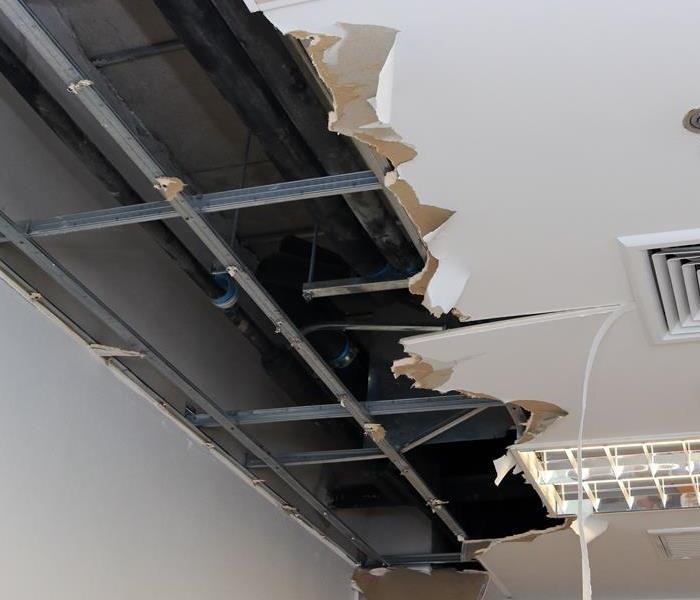 Water dripping from the ceiling can cause electrical and water damage to your property.
Water dripping from the ceiling can cause electrical and water damage to your property.
Water dripping from light fixtures can be a perplexing and potentially hazardous situation for homeowners. Not only does it pose a risk to your electrical system, but it also indicates an underlying issue that requires prompt attention. In this blog post, we will explore the possible causes of water dripping from light fixtures and provide actionable solutions to address the problem effectively.
Identify the Source
The first step in dealing with water dripping from light fixtures is to determine the source of the water. It could be due to various factors, including:
- Plumbing Leaks: A leaky pipe or plumbing fixture above the light fixture can cause water to seep through and drip onto the light.
- Roof Leaks: If your light fixture is located near the ceiling or on the top floor, a roof leak could be the culprit.
- Condensation: In some cases, condensation can form on pipes or HVAC ducts, leading to moisture accumulation and eventual dripping onto the light fixture.
Immediate Actions
If you notice water dripping from your light fixtures, take these immediate actions to mitigate any potential risks:
- Turn off the Power: As a safety precaution, turn off the electricity supply to the affected area from the circuit breaker.
- Place a Bucket or Container: Position a bucket or container under the light fixture to collect the dripping water and prevent further damage.
Addressing Plumbing Leaks
If the water source is identified as a plumbing leak, follow these steps:
- Call a Professional Plumber: It's essential to seek the assistance of a licensed plumber who can accurately locate and repair the leak to prevent further water damage.
- Temporary Measures: Until the plumber arrives, consider using temporary solutions like shutting off the water supply to the affected area or placing a bucket beneath the leak.
Dealing with Roof Leaks
If the water is entering through the roof, follow these guidelines:
- Contact a Roofing Professional: Engage a qualified roofing contractor to inspect and repair any roof leaks promptly.
- Mitigate Interior Damage: In the meantime, protect your home by covering furniture and floors with tarps or plastic sheets to prevent further water damage.
Managing Condensation Issues
In case condensation is the root cause, take these steps to address the problem:
- Insulate Pipes and Ducts: Apply insulation to pipes and HVAC ducts to prevent condensation from forming and dripping onto the light fixture.
- Improve Ventilation: Ensure proper airflow in your home by using exhaust fans, opening windows, or installing a dehumidifier to minimize excess moisture.
Water dripping from light fixtures demands swift action to safeguard your home and prevent potential electrical hazards. By identifying the source and following the appropriate steps, you can address the issue effectively. However, it is crucial to consult professionals for complex repairs and to ensure long-term solutions. Remember, timely intervention will not only protect your home but also provide peace of mind.


 24/7 Emergency Service
24/7 Emergency Service





